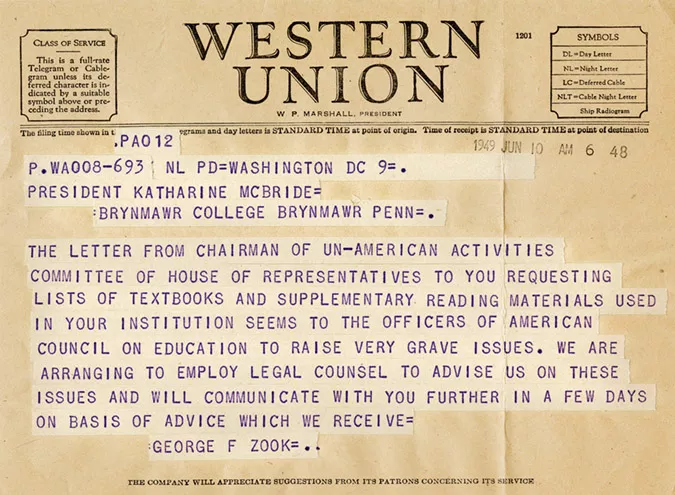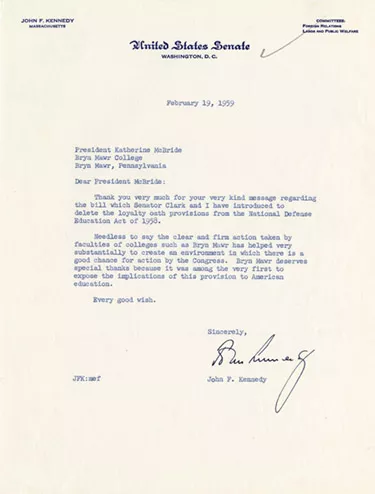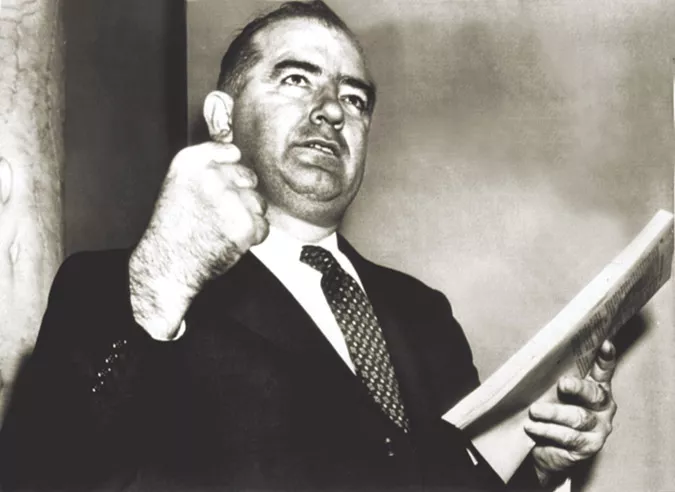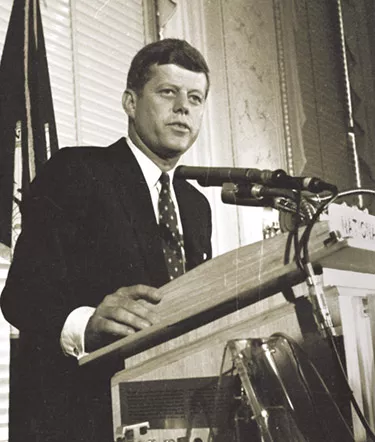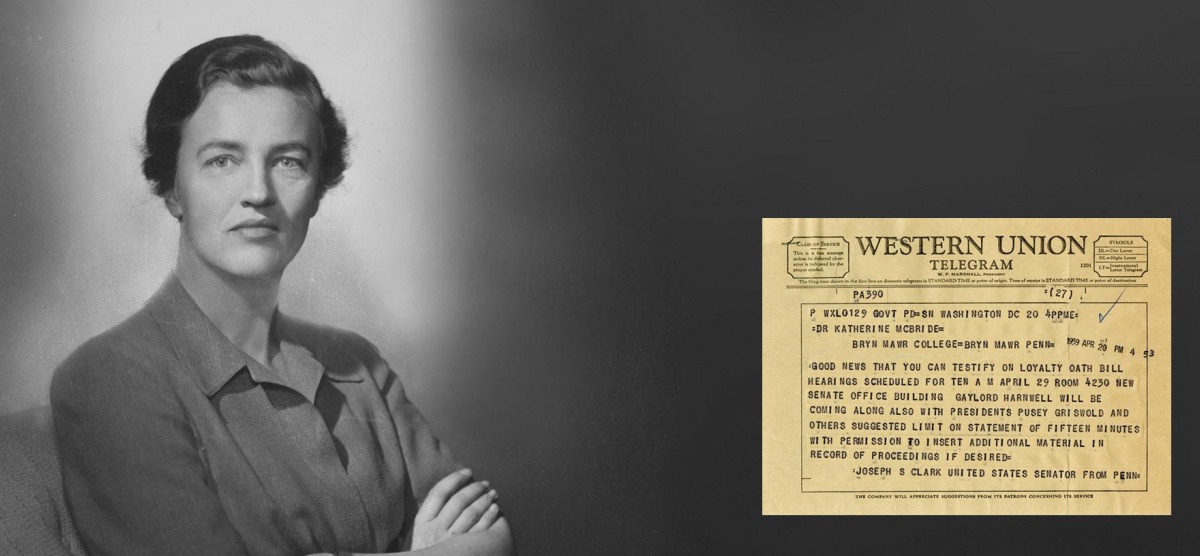
A Test of Loyalty
Bryn Mawr and the National Defense Education Act of 1958
Drawing on a proud Bryn Mawr legacy, President Katharine McBride brought the moral weight of refusal to bear on a national debate about academic freedom, individual rights, and the proper limits of government with respect to education.
In February 1959, the future president of the United States wrote a thank-you note to the president of Bryn Mawr. Senator John F. Kennedy was rallying legislative support to rescind what he called the “loyalty oath provisions” of the National Defense Education Act (NDEA) of 1958. Among the colleges that had taken “clear and firm action” to oppose these provisions, reads his typed letter to Katharine McBride, “Bryn Mawr deserves special thanks because it was among the very first to expose the implications of this provision to American education.”
President Eisenhower had signed the NDEA into law the previous September. A response to post-Sputnik fears that America was losing the space race with the Soviet Union through a dearth of rigorously educated scientists, the legislation sought to bolster the training of future defense professionals through infusing funds into science, math, and modern language programming. Setting important new precedents for federal support of higher education, the law also sought to make college more accessible through a generous student loan program.
But the final version, reflecting McCarthy-era anxiety about communism, attached a political fee to the loans: In order to receive the funds through their college or university, students had to sign an affidavit disclaiming support of “any organization that believes in or teaches the overthrow of the United States Government by force or violence or by any illegal or unconstitutional methods.” They also had to swear or affirm allegiance to the United States of America.
Early Action
The “clear and firm action” to which Kennedy refers was President McBride’s refusal to enroll the undergraduate college in the NDEA loan program, a stance she adopted with the approval of the Board of Trustees in December 1958. (She did apply for some loan funding at the graduate level, believing the impact of the requirements to be more limited in those programs.) Both Haverford and Swarthmore, Bryn Mawr’s close neighbors and Quaker peer institutions, also refused the funding rather than subject students to the loyalty contingencies.
The following April, McBride testified before Congress in support of Senator Kennedy’s efforts to change the law. Her fellow witnesses in the Senate Subcommittee on Education hearings included Presidents Hugh Borton of Haverford, Courtney Smith of Swarthmore, and Gaylord Harnwell of the University of Pennsylvania, as well as the leaders of the Association of American Colleges and the American Association of University Professors. Kennedy’s bill passed the Senate in 1959 but eventually stalled in the House of Representatives, and the loyalty requirements would remain binding for another three and a half years.
Although many institutions objected to the loyalty requirements, only a small handful at this stage took the further step of protesting them by boycotting the NDEA loan program and thereby setting an important early example of dissent as a national debate around the law unfolded. Through McBride’s words and actions together, Bryn Mawr helped set the terms of that debate—a vital conversation about academic freedom, individual rights, and the proper limits of government with respect to education that still has resonance today.
The Rationale of Refusal
In her testimony before the Senate Subcommittee on Education, McBride’s central objection to what she calls the “loyalty oath” is that it represents a danger to free thought and inquiry. Everyone, she stresses, not just the university community, must be on guard against not only “direct attack but also the more subtle erosion” of these freedoms, which she calls “a bulwark of American life.”
In support of her central assertion, McBride articulates two further objections. The first is that through the loyalty provisions, the act undermines its own goal of extending educational opportunity and so renders itself ineffective. Because of the loyalty test, she argues, conscientious individuals who could benefit from the loan programs would refuse to participate—not from lack of loyalty but on principle. Disloyal individuals, on the other hand, “would not hesitate” to take a loyalty oath.
McBride’s second objection, more far-reaching than the first, was that the loyalty requirements conveyed to Americans a damaging and unfair distrust in the nation’s intellectual community. It would be an “unfortunate handicap,” she says, for Congress to suggest to “those people in the country that do not know schools and colleges at first hand” that students and professors “are not just as loyal as themselves” and so required “a special test.”
To McBride, remaining loyal to her own students through preserving their trust was paramount.
Turning to the context of her own institution, McBride takes ownership of the trust issue in a way that is striking. Characterizing the oath and affidavit as invasions of the trust between the institution and its students, she refuses to foist the accountability for that mistrust back onto the federal government. Because the loan fund resides in the institution and is administered by it, she insists, “The institution itself is responsible.”
To McBride, remaining loyal to her own students through preserving their trust was paramount, outweighing the negative financial impact of losing the funding. “We believe that the handicap to the whole student group,” she says, “through invading our justified trust would be a greater loss.” As an institution, Bryn Mawr essentially passed its own loyalty test by refusing to subject its students to the one set by the federal government.
McPherson on McBride
Having served under McBride as freshman dean and dean of the College, President Emeritus Mary Patterson McPherson (1978–97) finds McBride’s willingness to lead by example at the national level unsurprising. “Miss McBride was always somebody who placed Bryn Mawr in a wider context,” she says. “So thinking about the leadership that one institution should be giving to the whole of higher education was very typical of the way she thought.” She was, McPherson goes on to say, “a woman of great courage, able to stand up for the stuff that mattered.” McBride’s response to the NDEA legislation reflects, to McPherson, both the sui generis qualities she associates with the College’s fourth president and a legacy of leadership consistent with Bryn Mawr’s institutional history and values.
Perhaps foremost in McBride’s response to the law, McPherson sees an expression of Bryn Mawr’s formative Quaker values. Unlike Haverford and Swarthmore, Bryn Mawr does not identify institutionally as Quaker. But the Quaker roots the College shares with its neighboring institutions run deep, and in fact, says McPherson, Bryn Mawr’s values “have been very real and have been based very much on how Quakers have thought about things.” In McBride’s “courage to stand up against inappropriate government intrusion,” in her strong sense of support for the individual, and in her willingness to “stand outside the mainstream” and “speak truth to power,” McPherson sees a reflection of the high value placed on individual conscience and principled action in the Quaker tradition.
McPherson points out that McBride would have been steeped in these institutional values under President Marion Park (1922–42), who led Bryn Mawr during McBride’s undergraduate and graduate years there. As a student “raised in the College under Miss Park,” says McPherson, “Miss McBride would have had many of the same ideals.” In Park’s extraordinary efforts to help refugee scholars, particularly Jewish scholars persecuted in Germany and elsewhere during World War II, resettle and work in the U.S., McBride would have experienced firsthand an example of “courageous leadership when in fact the country wasn’t being very courageous.”
During the Vietnam War a generation later, McBride’s successor Harris Wofford (1970–78) similarly showed morally courageous leadership in the face of social and government pressures that were antithetical to the values of the College. Retaining a stance taken by McBride during the last year of her tenure, Wofford refused compliance with a 1970 Pennsylvania law that made financial aid funding contingent upon institutions reporting student protesters of the war. Bryn Mawr, along with Haverford and other noncompliant schools, lost state aid money for a year before a federal court declared the law unconstitutional in a suit in which Haverford was a plaintiff. Wofford supported the lawsuit against the Pennsylvania Higher Education Assistance Agency as a friend of the court, filing an amicus brief on behalf of 28 Pennsylvania colleges and universities.
Beyond the president’s office, McPherson notes, the College’s trustees and alumnae/i have also played a critical role over the years by supporting the president and upholding consistency between the College’s actions and its values. “We’ve always been blessed with a board willing to stand up for what’s right,” she says, as well as with an alumnae/i community that can always be counted on.
An Army of Davids
The required affidavit disclaiming subversive associations attached to NDEA loan funding was finally repealed under President Kennedy in October 1962. (The oath or affirmation of allegiance, largely accepted as less insidious than the affidavit and perhaps seen as a necessary compromise, remained in place.) Practically the last back in as it had been among the first out, Bryn Mawr finally rejoined the loan program the following year.
In the four years between the bill’s initial passage and its revision, refusing the loan funding as a means of protest against the loyalty requirements gained traction among educational institutions, and ultimately more than 150 colleges and universities followed the example of dissent initially set by Bryn Mawr and a few of its peers. Harvard, under President Nathan Pusey, initially rejected what an editorial in the Crimson called the “extreme stand” adopted by Bryn Mawr, Haverford, and Swarthmore, opting instead for the “middle path” of accepting the funding while pressing for the repeal of the loyalty requirements. But Pusey changed course in response to pressure from Harvard’s faculty and withdrew the university from the NDEA loan program in November 1959. In a parallel action, President A. Whitney Griswold withdrew Yale from the program at the same time.
Bryn Mawr’s legacy of speaking truth to power, of fiercely protecting its students’ rights, and of preserving a relationship of trust with its student body positions, it well for navigating what McPherson calls “a very worrying time.”
A Crimson article covering the 1962 repeal of the affidavit requirement accurately positions Harvard as a leader in the national call to abolish the loyalty requirements, although not without rewriting the narrative a bit: it offers up a long list of schools, including, erroneously, Haverford, Swarthmore, Princeton, and others as “following suit” upon Harvard’s withdrawal from the loan program. (The statement was later corrected in a letter to the editor by a member of the Harvard community.)
Bryn Mawr seems less visible in this final chapter of the story. The Crimson piece on the repeal doesn’t mention the College, and if institutional heavyweights such as Harvard and Yale came later to the protest game, they were undoubtedly more influential as the movement to boycott the loan money gathered steam. But Bryn Mawr’s role, as Kennedy had pointed out years earlier, is deserving of recognition. Under McBride’s leadership, the College helped set in motion both a critical national dialogue and the army of Davids that brought the moral weight of refusal to the discussion.
To Be Continued
Bryn Mawr’s legacy of speaking truth to power, of fiercely protecting its students’ rights, and of preserving a relationship of trust with its student body positions, it well for navigating what McPherson calls “a very worrying time.” Today, the community faces grave threats to its professed and lived values, including efforts to bar travel to the U.S. by individuals from seven Muslim-majority countries and to terminate the Deferred Action for Childhood Arrivals (DACA) program. In response, President Kim Cassidy has issued unequivocal statements affirming the College’s ongoing commitment to a diverse student body and to supporting students of all nationalities regardless of citizenship status.
McPherson says she would be “deeply concerned” if the College’s administration, board, and alumnae/i community were to fail to stand up against these daunting new pressures on the institution and the students at its heart. But she has “every confidence,” given the promise of the College’s history, that they will stand up to them.
After all, she says, “It’s a pretty good history.”
McBride Scholars
The Katharine E. McBride Scholars are women over the age of 24 who are beginning or completing their college education. They participate in the same classes and programs as students of traditional age.
Published on: 03/12/2018
